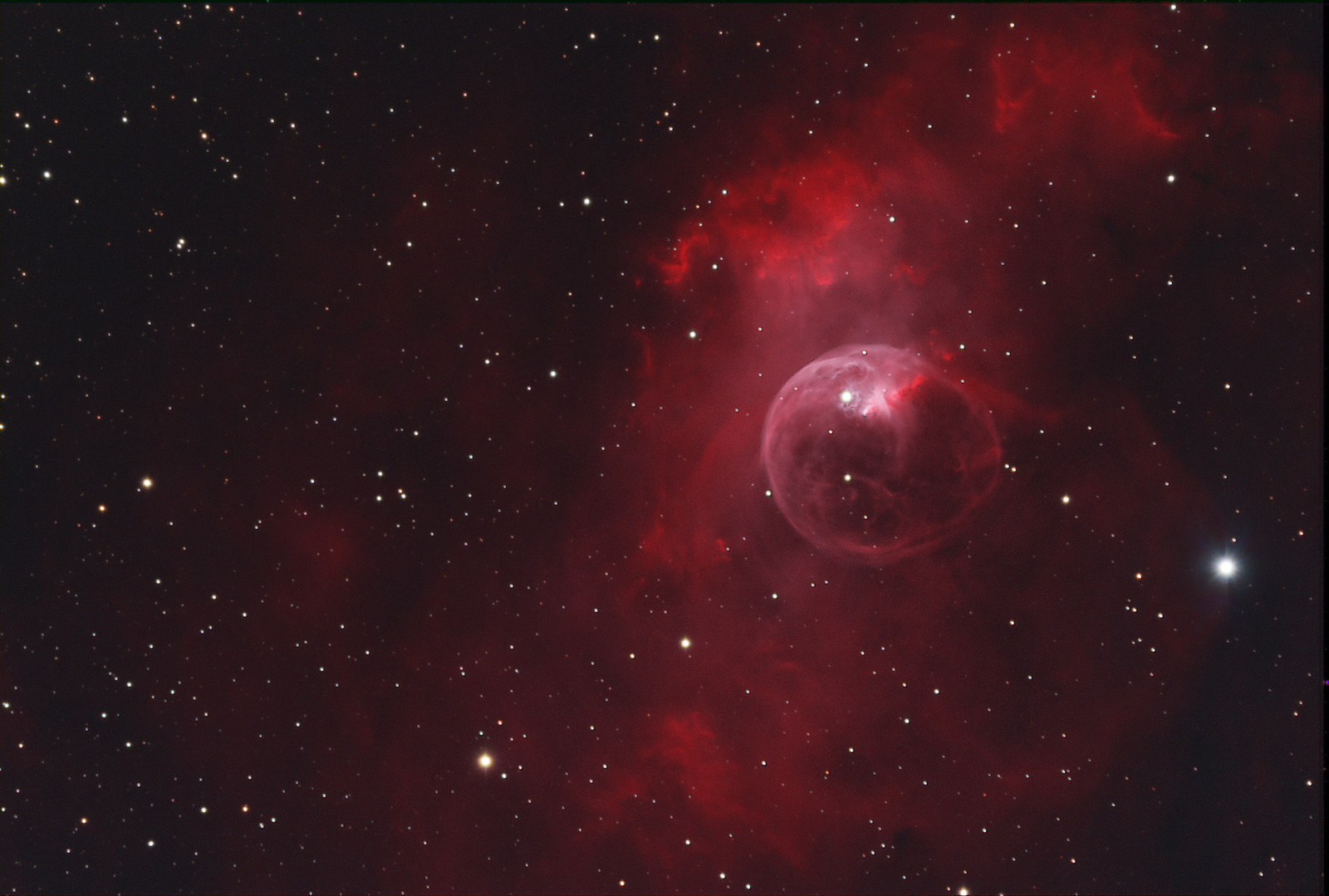
The Bubble Nebula is an ionized hydrogen emission nebula 7,800 light years away, created by stellar winds from the Wolf-Rayet O-type star SAO 20575.
There are only about 200 Wolf-Rayet stars known in our Galaxy. These stars are unusual for their hot surface and very high velocity stellar winds ejecting gas from the upper atmosphere into outer space. The Bubble’s Wolf-Rayet star is approximately 45 times more massive than our Sun and is the source for the ionization of the hydrogen. It is the nebula’s “central” star, although the star appears displaced from it’s geometric center.
The Nebula is a part of a larger emission complex named Sharpless 162, located in the Perseus arm of our Galaxy. There is a remarkable arcade of bright emission knots appearing West to the central star, usually referred to as “cometary”, as well as a bright emission loop “touching” the star. The Bubble Nebula is estimated about 300,000 to 400,000 years old.
The Bubble Nebula was discovered in 1787 by Sir William Herschel. It’s study is important to the understanding of young high-mass stars that are precursors to supernovae. It is also useful in understanding the effect of stellar wind driven shocks in the interstellar medium.
[layout cols=”2-3″ position=”first” textalign=”left”]
Image Data
Telescope: 10″ Aries f/15 Maksutov-Cassegrain on Astro-Physics 900GTO German Equatorial
Accessories: Moravian G1-0300 as Off-Axis Guider, 0.67X Astro-Physics CCD Telecompressor
Focal Length and Resolution: 2692 mm, 0.52″/pixel
Instrument: QSI 532wsg at -20 deg. C
Exposures: 3nm Narrowband [H II]: 8.25 hours [O III]: 12.75 hours, RGB: 2 hours, Total: 27.5 hours
Filter(s): Astrodon Narrowband and Tru-Balance E-Series
Exposure Date: August 19 to October 3, 2011
Seeing, FWHM: 0.9-1.5″
Processing Software: MaximDL, PixInsight, Photoshop
Image Acquisition Software: MaximDL, TheSky6, CCDAutoPilot, FocusMax, PinPoint
[/layout]
[layout cols=”1-3″ position=”last” textalign=”left”]
Object Data
Constellation: Cassiopeia
Type: Emission Nebula
Distance: 7,800 ly
Dimensions: 15′ x 8′
Magnitude: ~ 10 (V)
[/layout]
Processing Procedure
Debloomed all images in MaximDL 5
PixInsight: Calibrated, Registered and Integrated
[H II] and [O III] Data:
LRGB Combination (R=[H II], G & B=[O III]) (no L)
STF, ATrousWaveletTransform 3×3 Linear (L1 +0.4 S3,0.83,1) (L2 +0.4 S3, 0.77,1)
Histogram Transform
RGB Data:, LRGB Combination (no L), Background Neutralization, Histogram Transform
ATrousWaveletTransform K-Sigma to suppress background noise
Photoshop: Overlay RGB (Lighten) over [H II] and [O III], Noise Reduction
NASA/ADS Query
[wp_nasaads_query_importer_full ads_query_url=”/cgi-bin/basic_connect?qsearch=NGC7635″ max_num_authors=”20″ max_records_to_print=”10″]